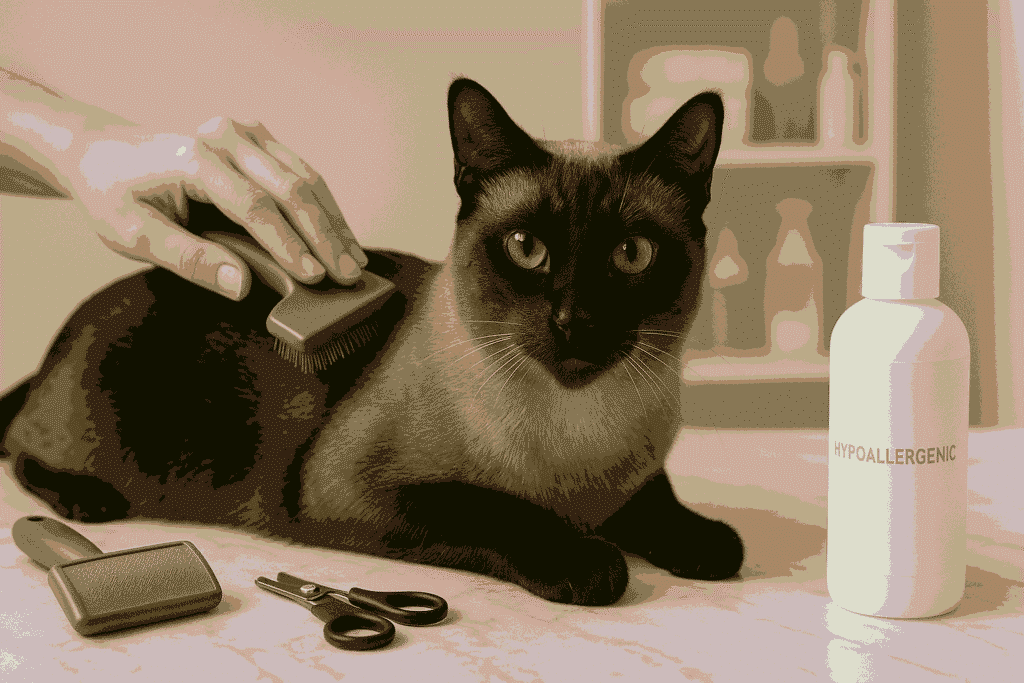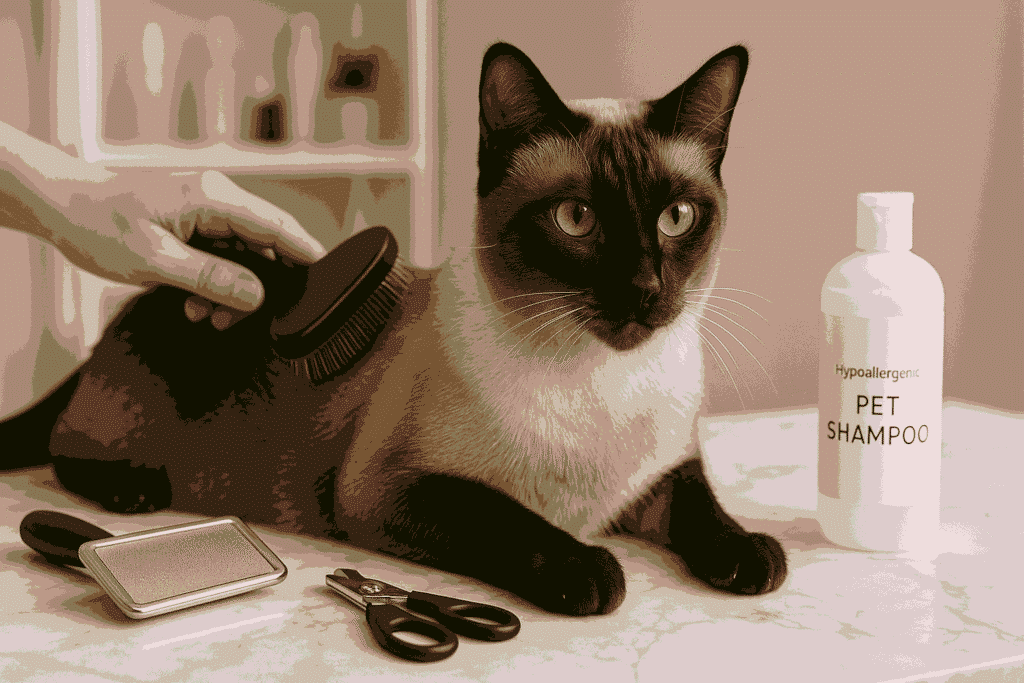Siamese cats are brilliant, vocal, and full of personality but their intelligence demands proper training. Whether you’re teaching basic commands or solving stubborn behaviors the right approach makes all the difference. This guide covers everything from litter training to advanced tricks helping you build a strong bond with your feline friend.
Training a Siamese cat requires patience and consistency. Their social nature means they thrive on interaction but boredom can lead to mischief. From stopping excessive meowing to leash training we’ll break down step-by-step methods that work. Positive reinforcement, mental stimulation, and structured routines are key to success.
Do you struggle with scratching, meowing or litter box issues? This guide has proven solutions. You’ll learn how to harness your Siamese cat’s intelligence while keeping them happy and well-mannered. Ready to transform your cat’s behavior? Let’s dive in!
✔ Siamese cats are smart but need consistent, reward-based training.
✔ Solve meowing, scratching, and litter problems with positive reinforcement.
✔ Advanced training (leash walking, tricks) keeps them mentally stimulated.
✔ Avoid punishment—focus on patience and engagement instead.
Siamese Cat Training: The Complete Guide for a Well-Behaved Companion
Siamese cats are intelligent vocal and highly social, making them both delightful and challenging companions. Proper training requires patience consistency and an understanding of their unique personality traits.
This guide covers everything from basic obedience to solving behavioral issues ensuring a happy and well-mannered Siamese cat.
Understanding Siamese Cat Behavior
Siamese cats are known for their:
✔ High intelligence – Quick learners but can be stubborn.
✔ Vocal nature – They “talk” frequently to communicate.
✔ Strong social bonds – Prone to separation anxiety if left alone too long.
✔ Playful curiosity – Need mental stimulation to avoid mischief.
Training Tip:
-
Use positive reinforcement (treats, praise, play).
-
Keep them engaged with interactive toys and puzzles.
-
Establish a consistent routine to prevent anxiety.
Summary: Understanding their personality is key to effective training.
Basic Training Essentials
Basic Training Essentials for Siamese Cats focus on short, engaging sessions (5-10 minutes) that leverage their intelligence and food motivation through positive reinforcement like treats, praise or play. Start with simple commands such as “sit,” “come,” and “stay,” using a clicker for precise timing and consistency and always reward desired behaviors immediately to reinforce learning.
Train in a quiet distraction-free environment to maintain their focus and be patient yet firm while Siamese cats learn quickly they may test boundaries, so consistency in daily practice is key.
By keeping training fun structured and reward-based you’ll build a strong foundation for obedience and strengthen your bond with your feline companion.
Effective Methods:
✔ Clicker Training – Great for teaching tricks and commands.
✔ Short Sessions (5-10 mins) – Maintains their attention span.
✔ Reward-Based Learning – Use treats or affection for good behavior.
First Commands to Teach:
-
“Sit” – Lure with a treat above their head.
-
“Come” – Reward when they respond to their name.
-
“Stay” – Gradually increase duration before rewarding.
Summary: Short, fun, and consistent sessions build a strong foundation.
Litter & Toilet Training for Siamese Cats
Siamese cats typically take well to litter box training, but success depends on proper setup and consistency. Choose a quiet, accessible location for the litter box and use an unscented, low-dust litter to accommodate their sensitive paws. Keep the box meticulously clean scoop daily and change litter regularly to encourage consistent use.
If accidents occur, avoid punishment; instead gently redirect your cat to the litter box and reward them for using it. For those interested in toilet training start by gradually elevating the litter box to toilet seat height before transitioning to a training seat and eventually removing the box entirely though not all cats will adapt.
Older or newly adopted Siamese cats may need retraining if they develop aversions due to stress or medical issues. By maintaining cleanliness providing positive reinforcement, and respecting their preferences, you can ensure reliable litter habits in your Siamese companion.
Litter Box Success:
✔ Location – Quiet, accessible spot.
✔ Cleanliness – Scoop daily, change litter regularly.
✔ Litter Type – Unscented, low-dust for sensitive paws.
Toilet Training (Advanced):
-
Start with a litter box on the toilet seat.
-
Gradually transition to removing the box (not all cats adapt).
Summary: A clean, well-placed litter box prevents accidents.
Solving Common Behavioral Issues
| Issue | Solution |
|---|---|
| Excessive Meowing | More playtime, puzzle feeders, ignore attention-seeking meows. |
| Biting/Scratching | Redirect to toys, never use hands as play objects. |
| Separation Anxiety | Gradual alone-time training, leave interactive toys. |
| Furniture Climbing | Provide cat trees, use deterrents (double-sided tape). |
Advanced Training & Enrichment
Advanced Training & Enrichment for Siamese cats involves engaging their sharp minds through leash training—starting indoors with a harness and rewarding calm behavior before venturing outside as well as teaching fun tricks like fetch high-five or agility courses using clicker training and breaking tasks into small reward-based steps.
Mental stimulation is equally important so incorporating puzzle feeders interactive toys, and hide-and-seek games helps prevent boredom and destructive behavior while keeping them physically and mentally active. Since Siamese cats thrive on challenges advanced training not only strengthens their skills but also deepens the bond with their owner through positive reinforcement and structured play.
Leash Training:
✔ Start indoors with a harness.
✔ Reward calm behavior before going outside.
Fun Tricks to Teach:
-
Fetch – Use lightweight toys.
-
High-Five – Guide their paw with a treat.
-
Agility Courses – Jumping through hoops or tunnels.
Mental Stimulation:
-
Puzzle feeders – Makes mealtime engaging.
-
Hide-and-seek games – Stimulates their hunting instincts.
Summary: Advanced training keeps them mentally sharp and happy.
Common Mistakes to Avoid
❌ Punishment – Creates fear, not learning.
❌ Inconsistency – Confuses your cat.
❌ Neglecting Playtime – Leads to destructive behavior.
Final Tip: Patience and positivity are the keys to a well-trained Siamese cat!
FAQs
1. Are Siamese cats easy to train?
Yes! Siamese cats are highly intelligent and quick learners. However, their strong-willed nature means training requires patience, consistency, and positive reinforcement.
2. Why is my Siamese cat so vocal?
Siamese cats naturally “talk” to communicate with their owners. Excessive meowing can signal boredom, loneliness, or a need for attention interactive play and mental stimulation can help reduce it.
3. How do I stop my Siamese cat from scratching furniture?
Provide scratching posts, use deterrents (like double-sided tape), and redirect their claws to appropriate surfaces. Never punish reward them for using the right spots.
4. Can I leash-train my Siamese cat?
Absolutely! Start indoors with a harness, letting them get comfortable before venturing outside. Use treats and praise to encourage positive associations.
5. Why is my Siamese cat ignoring the litter box?
Possible causes include a dirty box, wrong litter type, or stress. Ensure the box is clean, placed in a quiet area, and experiment with different litters if needed.
6. How do I train my Siamese cat to do tricks?
Use clicker training and break tricks into small steps (like “sit” before “high-five”). Reward with treats and keep sessions short (5-10 minutes).
7. Do Siamese cats get separation anxiety?
Yes—they bond deeply with owners. Gradually increase alone time leave interactive toys and consider a pet sitter if you’re away often.
8. What’s the best way to discipline a Siamese cat?
Never punish—it creates fear. Instead, redirect bad behavior (e.g., offer a toy for biting) and reward good habits.
9. How can I keep my Siamese cat from getting bored?
Puzzle feeders climbing trees and daily play sessions (like fetch or chase) keep their minds sharp and prevent mischief.
10. Can older Siamese cats be trained?
Yes! They may take longer to adapt but with patience and treats they can learn new behaviors even litter retraining.
Conclusion
By understanding their intelligence and social nature, you can train your Siamese cat effectively while strengthening your bond. Whether teaching basic commands or solving behavioral challenges consistency and positive reinforcement will ensure success.



